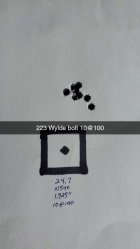On group sizes - The reason smaller count groups are generally smaller is a shift in their center is allowed. The conflict with load development is by the time you reach a statistically significant shot count to characterize the random errors, systemic errors like barrel heating or fouling have set in. Shooter errors are more likely as well.
It's not a bench rest gun and it won't be used to shoot bench rest matches. The 75 ELDm gives a good combination of BC, quality for the price, price, and availability. Even with that gun shooting to its potential, which is probably in the half to 3/4 moa 5 shot group range, you're chasing wisps of smoke with tenth grain and 5 thousandths 3 shot steps. Leave that stuff to the real Bench Rest shooters. My load development process is pick a bullet for the task, use a decent primer, do a pressure ladder measuring extractor groove expansion with a powder that nearly fills the case but does not produce a compressed load. Depending on the results, I may test the next faster powder to see if higher velocity can be traded for lower velocity spread. No, the lowest velocity spread won't produce the smallest group, but bench rest velocity spreads are a lot better than they let on and there is a lot of overlap.
With that split group, I'd start with checking the bedding of both the action and scope. Maybe try another scope as well.
On the case prep, my ELR processes and tools have bled over into my 223 prep. I anneal now, but I've also tried not annealing and letting the cases go full hard. Not annealing can work well. It takes about 3 firings for the cases to go full hard. You'll need to adjust the sizing die to get the same bump with each of the hardnesses, but probably not after the third firing. Mark the die at the locking ring split for each hardness. I have the AMP, but also had good luck with the Benchsource. With any carousel annealer, use a scrap case at the start and end to prevent extra pre or post heating with the first and last cases. It's not a life or death thing, but the effort is low.
After an anneal and metal pin wet tumble, I full length resize with a one piece die and expand with a Lyman M die. I heavily lubricate the inside of the neck with Imperial before expanding. If the necks are not turned, the neck tension won't be consistent if they're only sized from the outside. I also think there is value in the springback being in the inward direction but couldn't prove it. After sizing, the ID and OD of the necks are chamfered, then the ID of the neck is honed using a cordless drill at full drilling speed with a bore brush that started 1 caliber up. The cases are cleaned neck down in an ultrasonic cleaner filled with 140 F water, a few drops of dish soap as an emulsifier, and a little Lemishine to control the pantina. The subtext on this is I'm trying for a medium low neck tension that is extremely consistent without neck turning. If you want to skip neck turning, moving the bullet away from the shoulder junction is a good strategy. It also adds significant volume to the 223 case with the longer bullets.
With seating VLD bullets, especially those with plastic tips, check to make sure the tip isn't bottoming in the seating stem. You can buy VLD seating stems for most dies, but they may not be enough for the ELDm nose. I modify the seating stems as required in a mill. If you don't have a machine shop in the garage, some bedding compound in the stem works. Hornady sells seating stems dedicated to each of their bullets for their dies. They still need to be cleaned up and detailed. After the bullet is seated, check for copper dust at the end of the case. If you find it, a heavier chamfer is needed next time. There shouldn't be any marks on the bullet with a properly detailed seater stem, modest neck tension, and uncompressed load.
I also have 2 guns for similar purposes. The 6 is a 6XC though. The idea was to have a second gun to shoot while the first cooled off. Different ballistics are considered a plus, but they're not as far apart as many think. The BC on the 75 ELDm is fully twice that of a 55 fmjbt. AB has the G7 at 0.238. The 6mm 108 ELDm I use in the 6XC is only 0.267.

They both have ~2500 rounds through them. The 6 is on its second barrel. The first 223 barrel will likely see the fourth 6mm barrel installed.












